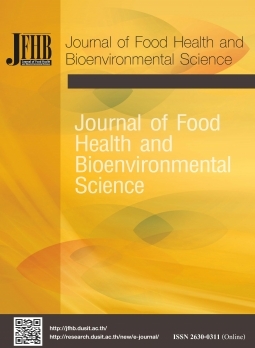Assessment of Water Quality in the Stream Flows into the Krasiow Dam based on Hydropsychid Larvae (Insecta, Trichoptera)
Keywords:
Gill Abnormalities, Morphology, Hydropsychidae, BiomonitoringAbstract
The use of altered gill morphology in hydropsychid larvae (Hydropsychidae: Trichoptera) as water quality biomonitoring was conducted in streams flows into Krasiow Dam, Dan Chang district, Suphan Buri Province, Thailand. Samples were collected over a period of one year January to December 2019. In total, 5,583 individual hydropsychid larvae belonging to four genera (Amphipsyche meridiana, Macrostemum indistinctum, Cheumatopsyche spp. and Potamyia spp.) were identified in this study. The percentage of individuals with at least some abnormality (HAI) and hydropsychid gill abnormality indice (HYI) was the highest in February and lowest in October. Canonical Correspondence Analysis (CCA) indicated the species Amphipsyche meridiana were positively correlated with water temperature, pH, and ammonia-nitrogen. Total dissolved solids were negatively associated with the Cheumatopsyche spp. and Macrostemum indistinctum. The outcomes of this study is expected that analyses of morphological deformations in tracheal gills could become a support for traditional physicochemical analyses of water quality or traditional biomonitoring.
References
American Public Health Association (APHA). (1992). Standard methods for the examination of water and wastewater (18th ed.). Washington, D.C.: American Public Health Association.
Cain, D.J., Luoma, S.N., Carter, J.L., & Fend, S.V. (1992). Aquatic insects as bioindicators of trace element contamination in cobble-bottom rivers and streams. Canadian Journal of Fisheries and Aquatic Sciences, 49, 2141–2154
Camargo, J.A. (1991). Toxic effects of residual chlorine on larvae of Hydropsyche pellucidula (Trichoptera; Hydropsychidae): A proposal of biological indicator. Bulletin of Environmental Contamination and Toxicology, 47, 261–265.
Clements, W.H., & Kiffney, P.M. (1994). Integrated laboratory and field approach for assessing impacts of heavy metals at the Arkansas River, Colorado. Environmental Toxicology and Chemistry, 13, 397–404.
Costello, M.J., McCarthy, T.K, & O’Farrell, M.M. (1984). The stoneflies (Plecoptera) of the Corrib catchment area, Ireland. Annales de Limnologie, 20(1–2), 25–34.
Cummins, T., & Farrell, E.P. (2003). Biogeochemical impacts of clearfelling and reforestation on blanket peatland streams. I. Phosphorus. Forest Ecology and Management, 180, 545–555.
Dudgeon, D. (1999). Tropical asian streams zoobenthos, ecology and conservation. Hong Kong: Hong Kong University Press.
Forbes, Y.E., & Forbes, T.L. (1994). Ecotoxicology in theory and practice. London: Chapman & Hall.
Gauch H.G.(1982). Multivariate analysis and community structure. Cambridge, England: Cambridge University Press.
Giesy, J.P., & Graney, R.L. (1989). Recent developments in and intercomparison of acute and chronic bioassays and bioindicators. Hydrobiologia, 188/189, 21–60.
Hamid, A., Bhat, S.U., & Jehangir, A. (2020). Local determinants influencing stream water quality. Applied Water Science, 10, 24.
Lawniczak, A.E., Zbierska, J., Nowak, B., Achtenberg, K., Grześkowiak, A., & Kanas, K. (2016). Impact of agriculture and land use on nitrate contamination in groundwater and running waters in central-west Poland. Environmental Monitoring Assessment, 188, 172.
Maitland P.S. (1978). Biology of fresh waters. Glasgow, NZ.: Blackie and Sons limited.
McCune, B., & Mefford M.J. (2006). PC-ORD mutivariate analysis of ecological data,Version 5. Oregon, USA.: MjM Software Design.
Merritt, R.W., & Cummins, K.W. (1996). Aquatic insects of the north America. Dubuque: Kendall Hun.
Morse, J.C. (2017). Trichoptera World Checklist. Retrieved from http://entweb.sites.clemson.edu/database/trichopt/
Ninon, A., & Prommi, T. (2019). Morphological gill abnormalities in the larvae of hydropsychidae (trichoptera: insecta) for assessment of water quality variables. Journal of Food Health and Bioenvironmental Science, 12(3), 20–27.
Pollution Control Department (PCD). (2014). Thailand state of pollution report 2014. Bangkok: Pollution Control Department, Ministry of Science Technology and Environment.
Palmer, M.W. (1993). Putting things in even better order: The advantages of canonical correspondence analysis. Ecology, 74, 2215–2230.
Petersen, R.C. (1986). Population and guild analysis for interpretation of heavy metal pollution in streams. In N.S. Jr. Cair (Ed.), Community toxicity testing ASTM STP 920 (pp. 180–198). West Conshohocken, PA: ASTM International.
Prommi, T. (2007). Taxonomy of Hydropsychidae (Trichoptera) in mountain streams of southern Thailand (Doctoral dissertation). Prince of Songkla University, Songkla.
Prommi, T. (2011). Some observations on altered morphology in Amphipsyche meridiana (Hydropsychidae: Trichoptera) larvae from the Pasak Jolasit Dam Outlet, central Thailand. Zoosymposia, 5, 408–412.
Prommi, T., & Thamsenanupap, P. (2013). Hydropsychid gill morphology (Insecta: Trichoptera) in association with water quality parameters. Journal of Applied Science in Environmental Sanitation, 8(2), 125–134.
Ratia, H., Vuori, K.M., & Oikaria, A. (2012). Caddis larvae (Trichoptera, Hydropsychidae) indicate delaying recovery of a watercourse polluted by pulp and paper industry. Ecological Indicators, 15, 217–226.
Resh, V.H. (1995). Freshwater macroinvertebrates and rapid assessement procedures for water quality monitoring in developing and newly industrialized countries. In W.S. Davies & T.P. Simon (Eds.), Biological assessement and criteria (pp. 167–177). Boca Raton, Florida: Lewis Publishers.
Rosenberg, D.M., & Resh, V.H. (1993). Freshwater biomonitoring and benthic macroinvertebrates. New York: Chapman and Hall.
Ter Braak C.J.F., & Verdonschot P.F.M. (1995). Canonical correspondence analysis and related multivariate methods in aquatic ecology. Aquatic Sciences, 57, 255–289.
Vuori, K.M. (1994). Rapid behavioural and morphological responses of hydropsychid caddis larvae (Trichoptera, Hydropsychidae) to sublethal cadmium exposure. Environmental Pollution, 84, 291–299.
Vuori, K.M. (1995). Species-and population-specific responses of translocated hydropsychid larvae (Trichoptera, Hydropsychidae) to runoff from acid sulphate soils in the River Kyrönjoki, western Finland. Freshwater Biology, 3, 305–318.
Vuori, K.M., & Kukkonen, J.V.K. (1996). Metal concentrations in Hydropsyche pellucidula larvae (Trichoptera, Hydropsychidae) in relation to the anal papillae abnormalities and age of exocuticle. Water Research, 30(10), 2265–2272.
Wiggins, G.B. 1996. Larvae of the North American Caddisfly Genera (Trichoptera)(2nd ed.). Toronto: University of Toronto Press.
Yule, C.M., & Yong, H.S. (2004). Freshwater invertebrates of the Malaysian region. Kuala Lumpur: Akademi Sains Malaysia.
Downloads
Published
How to Cite
Issue
Section
License

This work is licensed under a Creative Commons Attribution-NonCommercial-NoDerivatives 4.0 International License.








